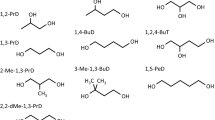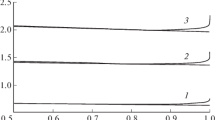Abstract
The v2 + v3 combination band of water has been recorded for nine alcohol-water solutions in which the volume fraction of water is less than 2% and for three alcohol-water solutions over the entire range of composition. In dilute solutions it was found that the fraction of “symmetrically” bonded water was, in general, smaller than in aprotic solvent-water systems. The fraction of nonbonded water protons was greater in alcohols of higher molecular weight and was also greater in tertiary alcohols than in primary ones. The 2vOH overtone band was recorded for three alcohols in alcohol-rich solutions. Water appears to break up the polymeric alcohol structure, and there appears to be a slight preference for water-water bonds over water-alcohol bonding. Raman spectra of the alcohol C−O stretching mode indicate that water-alcohol bonding is stronger than alcohol-alcohol bonding. The fraction of free alcohol and water OH groups appears to be smaller in solutions of intermediate composition than in the pure liquids. This increased “structure” of the solutions is consistent with the maxima occurring in the viscosity of alcohol-water solutions.
Similar content being viewed by others
References
O. D. Bonner and Y. S. Choi,J. Phys. Chem. 78, 1723 (1974).
O. D. Bonner and Y. S. Choi,J. Phys. Chem. 78, 1727 (1974).
N. Laiken and G. Nemethy,J. Phys. Chem. 74, 3501 (1970).
J. A. Pople,Proc. Roy. Soc. A205, 163 (1951).
N. D. Coggeshall and E. N. Saier,J. Am. Chem. Soc. 73, 5414 (1951).
H. C. Van Ness, J. Van Winkle, H. H. Richtol, and H. B. Hollinger,J. Phys. Chem. 71, 1483 (1967).
W. Luck,Physico-Chemical Processes in Mixed Aqueous Solvent, F. Franks, ed. (Heinemann, London, 1967), p. 11.
A. N. Fletcher,J. Phys. Chem. 76, 2562 (1972).
C. Bourderon and C. Sandorfy,J. Chem. Phys. 59, 2527 (1973).
F. Franks,Physico-Chemical Processes in Mixed Aqueous Solvents, F. Franks, ed. (Heinemann, London, 1967), p. 50.
R. L. Kay, C. P. Cunningham, and D. F. Evans,Hydrogen-Bonded Solvent Systems, A. K. Covington and P. Jones, eds. (Taylor and Francis, London, 1968).
T. L. Broadwater and R. L. Kay,J. Phys. Chem. 74, 3802 (1970).
E. K. Baumgartner and G. Atkinson,J. Phys. Chem. 75, 2336 (1971).
Author information
Authors and Affiliations
Rights and permissions
About this article
Cite this article
Bonner, O.D., Choi, Y.S. A spectroscopic investigation of the structure of alcohol-water solutions. J Solution Chem 4, 457–469 (1975). https://doi.org/10.1007/BF00645577
Received:
Revised:
Issue Date:
DOI: https://doi.org/10.1007/BF00645577




